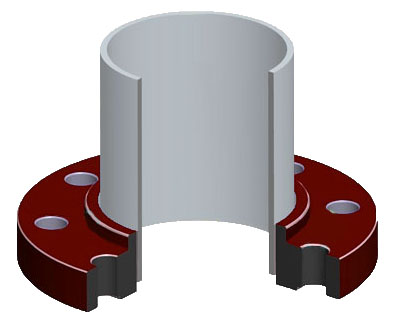An engineered stainless steel known for its high yield strength & decent corrosion resistance

- High Strength - About 2x stronger yield than 316 stainless steel
- Super Duplex - Decent general corrosion & cracking resistance
- Duplex Grades and chemistry: Duplex 2205, Super Duplex 2507, Zeron 100
- In-depth insight on Duplex 2205 and Super Duplex 2507
- Slip on flange features and benefits
- Datasheet for Super Duplex 2507
- Datasheet for Duplex 2205
Duplex 2205 and Super Duplex 2507 stainless steel slip on flanges are characterized by their high yield strength, which is twice that of the annealed yield strength of typical austenitic stainless steels, like 304 and 316 stainless steel slip on flanges. Because of this, Duplex 2205 and Super Duplex 2507 steel are some of the most common grades of duplex used for slip on flanges with Super Duplex 2507 slip on flanges being the more corrosion resistant grade of the two.
Super Duplex 2507 slip on flanges improved corrosion resistance lends itself well too applications prone to stress-corrosion cracking, crevice corrosion, pitting, erosion and general corrosion. Because of the properties of Duplex and Super Duplex stainless steel slip on flanges are often used in chemical processing, petrochemicals, power industry and seawater equipment.
Usage of both Duplex and Super Duplex stainless steel should be limited to temperatures below 570° F as extended elevated temperature exposure can embrittle this material.
The most common grades of Duplex flanges are Duplex 2205 and Super Duplex 2507. Gain more insight on these two grades by accessing our Duplex 2205 and Super Duplex 2507 overviews or by contacting our engineering experts.
Resources: Duplex & Super Duplex Torque Specs, Flange Dimensions, Flange Bolting Chart
Flange Types Available: Blind Flanges, Lap Joint Flanges, Slip On Flanges, Socket Weld Flanges, Threaded Flanges, Weld Neck Flanges
Duplex Slip On Flange Grades, Chemistry & Specifications
Duplex Alloy 2205
Duplex 2205, UNS S32205, is a stainless steel material, whose “Duplex” name is derived from the mixed microstructure which contains roughly equal portions of ferrite and austenite. This grade is the most popular variety and this two-phase material is a significant upgrade from 316 stainless steel in terms of both yield strength and corrosion resistance.
Duplex 2205 Specifications: ASME SA 182, ASME SA 240, ASME SA 479, ASME SA 789, ASME SA 789 Section IV Code Case 2603, ASTM A 240, ASTM A 276 Condition A, ASTM A 276 Condition S, ASTM A 479, ASTM A 790, NACE MR0175/ISO 15156, NORSOK MDS D45 Grade F51, UNS S31803, UNS S32205, W. NR./EN 1.4462, Werkstoff 1.4462 Duplex

Super Duplex Alloy 2507
Super Duplex 2507, UNS S32750, is a two-phase stainless steel and is particularly well suited for use in environments such as warm chlorinated seawater and acidic, chloride containing media. It has similiar properties to Duplex 2205 but is more corrosion resistant and performs well in moderately corrosive environments.
Super Duplex 2507 Specifications: EN 10216-5, ASTM A789; A790, ASTM A182 ASTM A182, ASTM A815, ASTM A240, EN 10088-2, ASTM A479, EN 10088-3 EN 10088, ISO 15156-3, NACE MR0175, Werkstoff 1.4410 S.Duplex

Zeron 100 / F55:
Zeron 100, UNS 32760, is commonly know as F55, which is a slight varient of Super Duplex 2507. This alloy is well suited or seawater applications.
Zeron 100/F55 Specifications: ASTM A 182, ASTM A 182 (Grade F55), ASTM A 240, ASTM A 276, ASTM A 473, ASTM A 479, ASTM A 790, ASTM A 815, ASTM A314, NORSOK MDS 055, UNS S32760, W. Nr./EN 1.4501, Werkstoff 1.4501

Mechanical Data

Duplex Steel Slip on Flange Features & Benefits
Duplex 2205 and Super Duplex 2507 slip on flanges are similar to the socket weld flange but without the socket shoulder. When using a socket weld flange, the pipe rests against this internal shoulder. Since a slip on flange does not have shoulder, the pipe can slide completely through the flange hub and is free to spin.
Advantages
- Typically lower in price than weld-neck flange, yet welding costs can be more.
- There is a reduced need to cut the pipe length accurately, making it easier to install.
- The slip on flange is free to spin on the pipe for easy bolt alignment.
Disadvantages
- They require two fillet welds: one fillet weld at the hub of the flange and a second weld at the inside diameter of the flange near the flange face.
- Though they can be used for high temperature and pressure applications, they typically are not as other flange types give a more secure joint.
